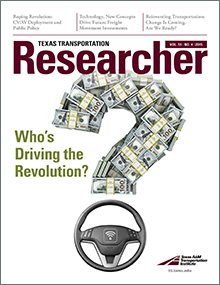The Texas A&M Transportation Institute (TTI) recently completed a wide-reaching effort to help expand the Texas Department of Transportation’s (TxDOT’s) freight transportation planning into the second half of the 21st century.
The TxDOT-sponsored project partnered TTI with the Center for Transportation Research (CTR) at the University of Texas at Austin. TTI Research Scientist Jolanda Prozzi and her team explored factors impacting future freight flows in Texas — including global trade patterns, changing business models, sociodemographic trends, climate change, technology trends and TxDOT’s role in freight planning.

The growing demand for rail transportation between Canada, Mexico and the United States has large impacts on Texas. TTI Research Scientist Juan Villa used national data sources to provide the most up-to-date rail infrastructure and traffic-flow information (i.e., imports/exports) for the project. This information will allow TxDOT districts and divisions, the Federal Highway Administration, and other local and regional planners to more easily plan for and respond to freight demands in the short and long terms.
In another key task, TTI and CTR researchers facilitated a Freight 2055 Roundtable that brought over 90 freight industry stakeholders together for a one-day workshop. Participants included representatives from ports, rail, highways, cities, corporations, metropolitan planning organizations, logistics service providers, engineering and planning firms, consulting firms, and academia.
“The roundtable facilitated an open discussion of major trends and factors that influence freight company decisions, as well as what Texas freight stakeholders expect of TxDOT in planning for and developing a future freight transportation system that will meet business needs,” says Prozzi.
Freight stakeholders are looking to TxDOT to pilot new technologies and strategies, such as enhanced weigh-in-motion deployment, truck-only lanes and overweight/oversize urban corridors. These strategies are just a few of the many suggested by roundtable participants to prepare Texas’ freight transportation system for 2055.
“This project demonstrates how important it is to communicate and partner with all public, private and international stakeholders in moving forward,” Prozzi explains. “The people whose lives revolve around freight agree that TxDOT’s leadership in proactive planning will ensure an efficient, reliable and safe freight transportation system by 2055.”
